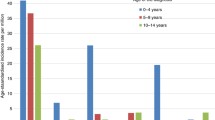Abstract
We have reviewed the records of the 16,564 cases of childhood cancer diagnosed from 1971 to 1983 which were reported to the National Registry of Childhood Tumours in Great Britain for the presence of underlying genetic disease in order to estimate the proportion which results from inherited mutations. A genetic condition was listed for 509 patients, or 3.07% of the total number of tumours. The most frequently recorded diagnoses were: bilateral retinoblastoma (162 cases); Down syndrome (135); neurofibromatosis (90); hereditary Wilms' tumour (71); and tuberous sclerosis (20). The highest hereditary fractions at individual tumour sites were seen for: retinoblastoma (37.2%); kidney (7.2%); leukaemia (2.6%) and brain and spinal cord (2.0%). When information about family history from published reports was incorporated into the figures calculated from Registry data the total genetic fraction was estimated to be 4.2%. We conclude that there is a clear genetic basis for a small minority of the cancers of childhood, but ethnic variation and the lack of known environmental determinants suggest that the total influence of heredity may be higher.
Similar content being viewed by others
Author information
Authors and Affiliations
Rights and permissions
About this article
Cite this article
Narod, S., Stiller, C. & Lenoir, G. An estimate of the heritable fraction of childhood cancer. Br J Cancer 63, 993–999 (1991). https://doi.org/10.1038/bjc.1991.216
Issue Date:
DOI: https://doi.org/10.1038/bjc.1991.216
- Springer Nature Limited
This article is cited by
-
Recurrent somatic mutations and low germline predisposition mutations in Korean ALL patients
Scientific Reports (2021)
-
Space-time clustering of childhood leukemia in Colombia: a nationwide study
BMC Cancer (2020)
-
Can legal restrictions of prenatal exposure to industrial trans-fatty acids reduce risk of childhood hematopoietic neoplasms? A population-based study
European Journal of Clinical Nutrition (2019)
-
The influence of prenatal exposure to trans-fatty acids for development of childhood haematopoietic neoplasms (EnTrance): a natural societal experiment and a case-control study
Nutrition Journal (2018)
-
Family history of cancer and the risk of childhood solid tumours: a Norwegian nationwide register-based cohort study
British Journal of Cancer (2018)




